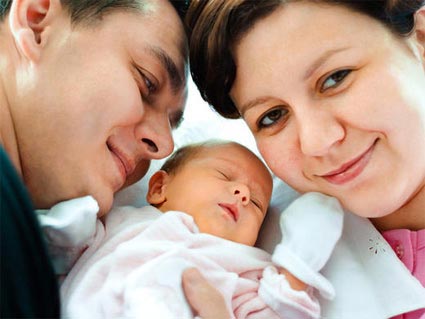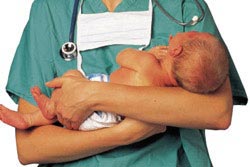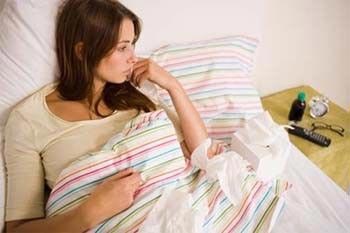Taking right safety precautions after post delivery haemorrhage can help to prevent complications. Read on to know more about the safety precautions after post delivery haemorrhage. Following childbirth, the hospital provides the woman with adequate care in the form of precautions to deal safely with post delivery haemorrhage. In order to access the situation effectively the signs of placental separation are watched carefully. Post delivery haemorrhage actually becomes a strong possibility when the placenta does not get delivered spontaneously. Given below are the usual precautionary measures that the physicians resort to under such circumstances: In this articleDo Your Bit to Strengthen the Contractions Massaging the UterusBe Regular with Your Ice-PacksBe Regular with Medicines Do Your Bit to Strengthen the Contractions This is an important point to note, the contractions that you were experiencing in the later stages of your pregnancy do not disappear after the birth of your baby. The contractions of the uterus are still on and they are very important. They help the uterus to shrink back to its previous size which will in turn help in the prevention of excessive bleeding or post delivery haemorrhage. Apart from medications, you must note that regular nursing to your newborn will strengthen these contractions. This is an important precautionary measure in dealing with post delivery haemorrhage. Massaging the Uterus During Post Delivery haemorrhage, the remaining clots of blood must be expelled from the system. Massaging the uterus is a way that aids the process and brings down the rate of haemorrhage. It has been found that in over 70% of the cases, the poor tone of the uterus is the primary reason behind severe post delivery haemorrhage. Therefore, to ease in the condition and reduce the pain, the uterus needs to be massaged as a precautionary step. This can be performed by certain relaxation and breathing techniques. And at no point of time you can allow your abdominal muscles to be strained. This is an important and effective technique apart from regular medications. Be Regular with Your Ice-Packs The vagina and the area between the opening of the vagina and rectum might be in a severe state due to childbirth and post delivery haemorrhage enhances the discomfort further. Episiotomy is done in this area which has caused the tearing and laceration. Apart from the regular medicines that aid in the healing of the area, ice packs are also suggested to reduce the pain and swelling. When you are under clinical care in the hospital and even after you are discharged, you must be diligently regular in taking care of this area. Be Regular with Medicines In order to aid the contraction and offer relief from pain and swelling, medication is administered. Given your condition you might not be allowed to eat and drink as a precautionary measure. It is important on your part to adjust to it and survive on injections till the period the doctor thinks fit. At a later stage of post delivery haemorrhage, ibuprofen or acetaminophen is administered. Depending on the condition the doctor might even opt for stronger medications like Tylenol #3. Excessive haemorrhage also carries the risk of probable infection. So, strong antibiotics are administered as a precautionary measure. Regular vitamins and iron supplements are a must. Apart from the above measures, the woman should ensure that her bladder should be empty at most times, that is, do not allow it to get completely filled. Always be in discussion with your health care provider and follow the advice given to you. Talk about your problems and you will better understand your personal risk factors and chalk out a prevention strategy to cope with post delivery haemorrhage effectively.
Taking right safety precautions after post delivery haemorrhage can help to prevent complications. Read on to know more about the safety precautions after post delivery haemorrhage. Following childbirth, the hospital provides the woman with adequate care in the form of precautions to deal safely with post delivery haemorrhage. In order to access the situation effectively the signs of placental separation are watched carefully. Post delivery haemorrhage actually becomes a strong possibility when the placenta does not get delivered spontaneously. Given below are the usual precautionary measures that the physicians resort to under such circumstances:
Do Your Bit to Strengthen the Contractions
This is an important point to note, the contractions that you were experiencing in the later stages of your pregnancy do not disappear after the birth of your baby. The contractions of the uterus are still on and they are very important. They help the uterus to shrink back to its previous size which will in turn help in the prevention of excessive bleeding or post delivery haemorrhage. Apart from medications, you must note that regular nursing to your newborn will strengthen these contractions. This is an important precautionary measure in dealing with post delivery haemorrhage.
Massaging the Uterus
During Post Delivery haemorrhage, the remaining clots of blood must be expelled from the system. Massaging the uterus is a way that aids the process and brings down the rate of haemorrhage. It has been found that in over 70% of the cases, the poor tone of the uterus is the primary reason behind severe post delivery haemorrhage. Therefore, to ease in the condition and reduce the pain, the uterus needs to be massaged as a precautionary step. This can be performed by certain relaxation and breathing techniques. And at no point of time you can allow your abdominal muscles to be strained. This is an important and effective technique apart from regular medications.
Be Regular with Your Ice-Packs
The vagina and the area between the opening of the vagina and rectum might be in a severe state due to childbirth and post delivery haemorrhage enhances the discomfort further. Episiotomy is done in this area which has caused the tearing and laceration. Apart from the regular medicines that aid in the healing of the area, ice packs are also suggested to reduce the pain and swelling. When you are under clinical care in the hospital and even after you are discharged, you must be diligently regular in taking care of this area.
Be Regular with Medicines
In order to aid the contraction and offer relief from pain and swelling, medication is administered. Given your condition you might not be allowed to eat and drink as a precautionary measure. It is important on your part to adjust to it and survive on injections till the period the doctor thinks fit.
At a later stage of post delivery haemorrhage, ibuprofen or acetaminophen is administered. Depending on the condition the doctor might even opt for stronger medications like Tylenol #3. Excessive haemorrhage also carries the risk of probable infection. So, strong antibiotics are administered as a precautionary measure. Regular vitamins and iron supplements are a must.
Apart from the above measures, the woman should ensure that her bladder should be empty at most times, that is, do not allow it to get completely filled. Always be in discussion with your health care provider and follow the advice given to you. Talk about your problems and you will better understand your personal risk factors and chalk out a prevention strategy to cope with post delivery haemorrhage effectively.




























